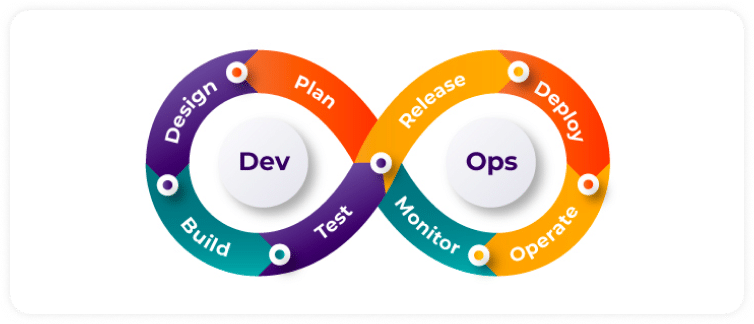Work in a much more collaborative way by removing silos and aligning teams to deliver continuous improvements to your CX operations.
Making the change to a DevOps methodology within a call center cannot be done overnight. From getting buy-in from departments to sourcing the right technology to make it all happen, there are many steps that need to be thought through ahead of its implementation.
In this guide, we will walk you through the processes for a smooth transition and effective operation. If you would prefer to download a PDF version of this guide, you can access it here.
Why DevOps?
The goal of implementing DevOps in a contact center is usually to improve and shorten the system’s development cycle through delivering features, fixes, and updates frequently, and where possible, automating to align with the objective(s) of the business.
The mindset of DevOps focuses on continuous testing, regular delivery, and streamlining the processes between design, build, test, and release phases in a software’s development lifecycle.
However, DevOps is more than software and procedures, it’s a mindset and culture shift. Moving from separate departments into a collaborative team, that will work together to achieve the shared objective – faster and more reliable deployments. By adopting these practices you’ll have the potential to improve customer experience with speed and quality.

Ready to get started?
We love high performing contact centers. Let us show you how we can help improve yours.
Principles of DevOps
The methodology of DevOps relies on communicaton amongst the technical and operations teams.
Collaboration
Development and operations teams must work together and share the responsibility of the delivered release. This requires constant and effective communication between both departments. To achieve this:
- Agree your goals and set common objectives
- Become one team to build trust
- Produce a clear roadmap that outlines the path set to achieve your objectives
Automation
This is essential to moving to a DevOps methodology. You will be required to automate builds, functional and regression testing, as well as being able to automate feedback on code quality and monitor the live environment. According to the Sate of DevOps report, high performing organizations automated:
- 33% more configuration management
- 27% more testing
- 30% more deployments
- 27% more change approval processs than other teams
Continuous integration
Continuous integration helps the productivity of the developers by finding and addressing problems faster so that releases can be delivered quicker. This is acheived by having a single repository for source code, automated builds, running automated testing, and the team having access to the latest version at all times.
Continuous delivery
This is the ability to get software into production safely, efficiently, and sustainably. This is done by always producing code that is “ready to go into production”. This is supported through automated testing, working in small batches, and pursuing continuous improvement, helping to reduce deployment pain and higher IT performance.
Continuous deployment
Being able to deploy continuously results in better throughput and more predictable and reliable releases. For this to happen, continuous testing needs to be in place so that you can ensure every change can be immediately tested and released without manual intervention.
Continuous testing
The practice of continuous testing relies on executing automated tests that are developed to test the end-to-end system and follow the route of the customer’s journey. This methodology is all about testing early, faster, more often, and automating wherever you can. Automated testing will allow for UAT, functional, regression, and load testing to be run regularly without putting additional strain on the DevOps team resources.
If you try and rush the implementation you will be doomed for failure. But, if you follow our guidance and roll out your DevOps implementation in easy to manage steps, you can reap the benefits.
Where to start?
Your customer experience (CX) should be the first and foremost consideration that you plan your DevOps implantation around. Quality in your customer service delivery cannot be comprimised, so it’s essential to establish early on what a good customer journey looks like. Use experience-based suggestions from your call center agents, performance reports from your current system, as well as feedback from clients in order to plan and design products and bug fixes that will address these needs. This approach will quickly result in positive outcomes that will justify and validate the decision to deploy DevOps throughout the business.
Starting out with this knowledge, you will be able to allocate resources proportionately, select and integrate the right DevOps tools, assign tasks to the correct teams, and streamline your production pipeline effectively. Another benefit of starting with CX is that you will already have mechanisms in place or monitoring your CX success (NPS, CSAT etc.), and through these metrics, you can quickly see the impact that DevOps can deliver.
There are seven key considerations that will help you implement a successful DevOps strategy within your contact center.
Communcation is key
When innovation is brought into any area of the business, there will always be a level of resistance to change. Before bringing your teams into a DevOps methodology it’s important that they understand why and how this will change their day-to-day roles.
Communicating this early on in the process will make sure no one feels blindsided or at risk due to these changes being rolled out. Focus on the pain points that the solution of DevOps is being brought in to resolve and how this will improve their work, as well as the benefits to the business and customer experience.
It’s also important to highlight where any challenges may be within this change. DevOps will not mean that all manual testing will stop. With continual testing and more resources to test all system configurations, issues or errors that may have remained unnoticed through manual testing can be identified and resolved faster, before they impact the customer’s experience thanks to frequent tests, monitoring, and continuous feedback loops.
Changing culture
For a DevOps approach to be successfully deployed within a contact center environment, it’s important to acknowledge and highlight the cultural changes that will be necessary to remove the silo mentality from the development, QA, and operations teams.
By changing the way responsibilities are split so that every member of the DevOps team is working towards the same business goal, the repetition of workload across departments will be reduced. This will also drive efficiencies when pushing a viable release into the live contact center environment.
From an operations and QA perspective, they will see changes coming through regularly and should be reporting back to the development team on how these changes are affecting the operations of the business. Creating a continuous feedback loop and sharing insights to drive the future development of the call center’s environment will help to continuously improve the customer’s experience and mitigate risk.
To ensure that this shift is as smooth as possible, you should look at every development innovation and how the end customer uses it. In the past, you may have had situations where a change has taken place and the developers have built to the brief. However, how they anticipate the system being used, and how a customer actually uses it can be very different. By always testing and working from the customer’s point of view, the transition from staging into live should be as smooth as possible.
Testing individual pices of code will now take on a more comprehensive approach in that developers will have an overview of how the code performs throughout the deployment and into the live environment. This increased visibility will limit downtime as the DevOps team wil be far more responsive to any other features in the system being affected by the changes being deployed.
Free business case template
Get buy-in from your business stakeholders to implement DevOps practices in your contact center

Planning Stage
The planning stage is where you will schedule all elements of a project and allocate resources. To ensure speed and quality, include the following best practices:
- Get set for continuous testing by specifying which tools must be used to monitor the new deployment.
- Prepare for configuration management – this refers to how your updates will be scheduled and how you will ensure consistency across all servers as you deploy the new configurations.
- Launch small experiments with short feedback cycles so that your team can test and learn throughout each project.
Design stage
This stage will impact everything else, so it is critical that the design of the development is done through the perspective of the customer.
This can be achieved by focusing on the common customer journey issues and identifying what can resolve them. Having clarity at this stage, and an understanding of the anticipated outcomes, ensures that all stakeholders are in agreement and the development team has the required information to deliver the necessary changes.
Testing stage
Before the talk of continuous testing becomes a monster to be feared by your DevOps team, consider how you can automate areas of your testing process to cover more user variations automatically in minutes, instead of weeks with manual testing.
Many of the tests that are carried out before and after the deployment stage will be repetitive and easy to move from manual testing to automated. For example, manual functional and regression testing can take weeks for your development and QA teams to complete. However, creating scripts that can be run continuously at each change will reduce risk to your live environment by covering 90-100% of the customer journey’s touchpoints, compared to an average 20-30% with manual testing alone.
Scalability testing is another area that can be automated as you move to DevOps. This will cut out any nasty surprises making their way into production, as you can verify the new build has not introduced any bottlenecks into the environment as you go.
This step cannot be overlooked within your DevOps process when you consider the number of options that are available to a customer when connecting with a contact center.
Test automation progression
Stay focused on the goal

Unit
Feature or focused testing on individual component

Integration
Systems communicate with one-another

Regression
You’ve added or updated a new feature, has it impacted any old features?

Performance
Did anything you do change how it scales? Are there non- linear bottlenecks?

Monitoring
Post deployment ‘day 2’, Ops ensure patches or config changes have not impacted CX
- Feature or focused testing on individual component
- Systems communicate with one-another
- You’ve added or updated a new feature, has it impacted any old features?
- Did anything you do change how it scales? Are there non-linear bottlenecks?
- Post deployment ‘day 2’, Ops ensure patches or config changes have not impacted CX
So, how should you implement your DevOps testing processes?
1. Build the foundation
To have the right infrastructure in place to implement DevOps in your call center, you will first need to have the right software in place to monitor and highlight any potential errors within your environment. This allows repetitive tests required as a result of more regular deployments to be handled through automated testing, freeing up your developers to move into the next development sprint.
2. Get everyone using the same technology
To streamline your systems and processes a centralized repository for all members of your DevOps team is highly recommended. This allows everyone to ingest information, exectute tests, validate current documentation, and easily export any findings to be shared as needed. Once in place, your call center will be able to eliminate redundant systems from your processes and individual teams to allow for a more coordinated, single platform to be used across the teams.
Free Automated Testing Vendor Comparison Checklist
Download to easily compare different systems side by side to find the right solution for your organization.

3. Standardize and reduce variability
Continuous testing allows your DevOps team to work together to create a standard customer experience testing process. By standardizing and introducing automated testing capabilities, your contact center will benefit from a faster deployment while eradicating the chances of human error.
Once you’re set-up, here are some key points to consider to help you get the most out of your continuous testing process:
- Functional and regression testing – validate that the application is functioning as intended and make sure that the new changes have been effective.
- Test in staging, verify in production – size does matter. Your lab environment won’t be as big as your production, so be sure to continue testing once in production to verify it can handle the capacity, as well as any cloud or remote-based call center resources that will be needed.
- Test the full customer experience journey – you will need a test sandbox instance so you can test all of the end-to-end customer journey options.
- Test for success, prepare for failure – understand how the environment is supposed to scale and plan testing around this through stress testing. Be prepared for testing to throw up expected errors and build the time needed to fix them into your timescales.
- Collaboration is key – ensure you are involving subject matter experts of the full technology stack so that everyone is aware of what changes are coming, and assist on any required troubleshooting.
- Establish performance baselines with load testing, monitor new deployments in production – by continuously testing your environment, with every new deployment you can monitor any performance issues as they arise.
Once your testing procedures are set up, you can enter the phase of fine-tuning the best way to manage testing and the errors that are found.
Creating an information feedback loop is central to a successful DevOps implementation. Your development team can anticipate and resolve issues in the pre-production environment by having an accurate overview of the live enviroment, granting them more independence to take a proactive approach to bug fixing without relying on QA or operations. The latter teams will be notified of changes thanks to the documentation process you have put in place.
Release stage
Once testing has confirmed that changes perform as expected, and at scale, the hand-off process can begin. There should also be monitoring to capture any customer experience (CX) issues as it moves into production. Load testing should also be carried out to confirm that customers do not experience any problems by simulating real-world traffic volumes and testing across all channels in the customer journey.
Monitoring
Continuously monitor your environment and capture any potential points of failure so that you can ensure a reliable service for the end-to-end customer journey. Anything that comes up at this stage can be used to loop back into planning and the cycle can begin again.
Pitfalls to watch out for
As with any change within a company, DevOps will have its own pros and cons to be mindful of. Having the foresight of what could become a hurdle in your DevOps implementation, and having the strategies to overcome them, you’ll be in the perfect position to deal with any hiccups you may experience.
Not having a lead
For your DevOps migration to be successful you will need someone to take ownership of the project to see it through and keep everyone else accountable. Remember, this isn’t just about the strategic investment but the cultural changes that will be needed too. CX doesn’t just stop at the DevOps team: sales, marketing, and customer services are also going to be affected by the changes that are introduced to your internal structure. Whoever this role is assigned to will need to have broad aithority and budget over people and processes.
Not setting clear KPIs
It’s important that your KPIs work for the collaborative structure of your DevOps team and that everyone is aware of what they are being measured against. Critical KPIs should be widely distributed across the organization so that CX can be viewed at an operational level.
Not having the right processes in place
If the implementation ends up in late nights and long hours to get the release deployed, or worse still, to fix issues in the live environment, there has been an oversight in the processes.
This will usually come down to the testing, if testing has not been automated or implemented correctly, bugs and issues will arise later than expected and cause bigger issues. Making sure you have an automated testing process and software that provides your team with the support needed will remove the chances of this occurring.
During the process development for your migration, you will also want to evaluate any manual processes you have in place across the teams and look for efficiencies and improvements that can be made during the transition. Not only can this reduce the chance of human error, but you will also be likely to avoid project delays or quality issues due to lack of resources.
Not streamlining environment migration
The biggest frustrations during development and deployment tend to come from moving between different environments, from development to QA, through to staging and production. By having a centralized repository you can avoid having to rework elements of the deployment or the introduction of bugs as code moves through the different stages.
Measuring the user experience
You will have to define a set of metrics so that you can use an automated monitoring tool to spot any changes to the user experience based on the improvements you have implemented. By measuring and testing this regularly, you will be able to clearly see the ROI your DevOps has had on overall CX and pinpoint areas that can be optimized next.
As you approach the implementation within your call center, take the time to review each stage we have discussed above to make sure all your bases are covered, and that all members of the newly collaborated team are on the same page every step of the way.
We have worked with many organizations to help get their tool stacks set up and ready to move to a more agile development cycle. If you would be interested in finding out more about how Occam’s Experience Testing System fits into your DevOps approach, get in touch by clicking here








